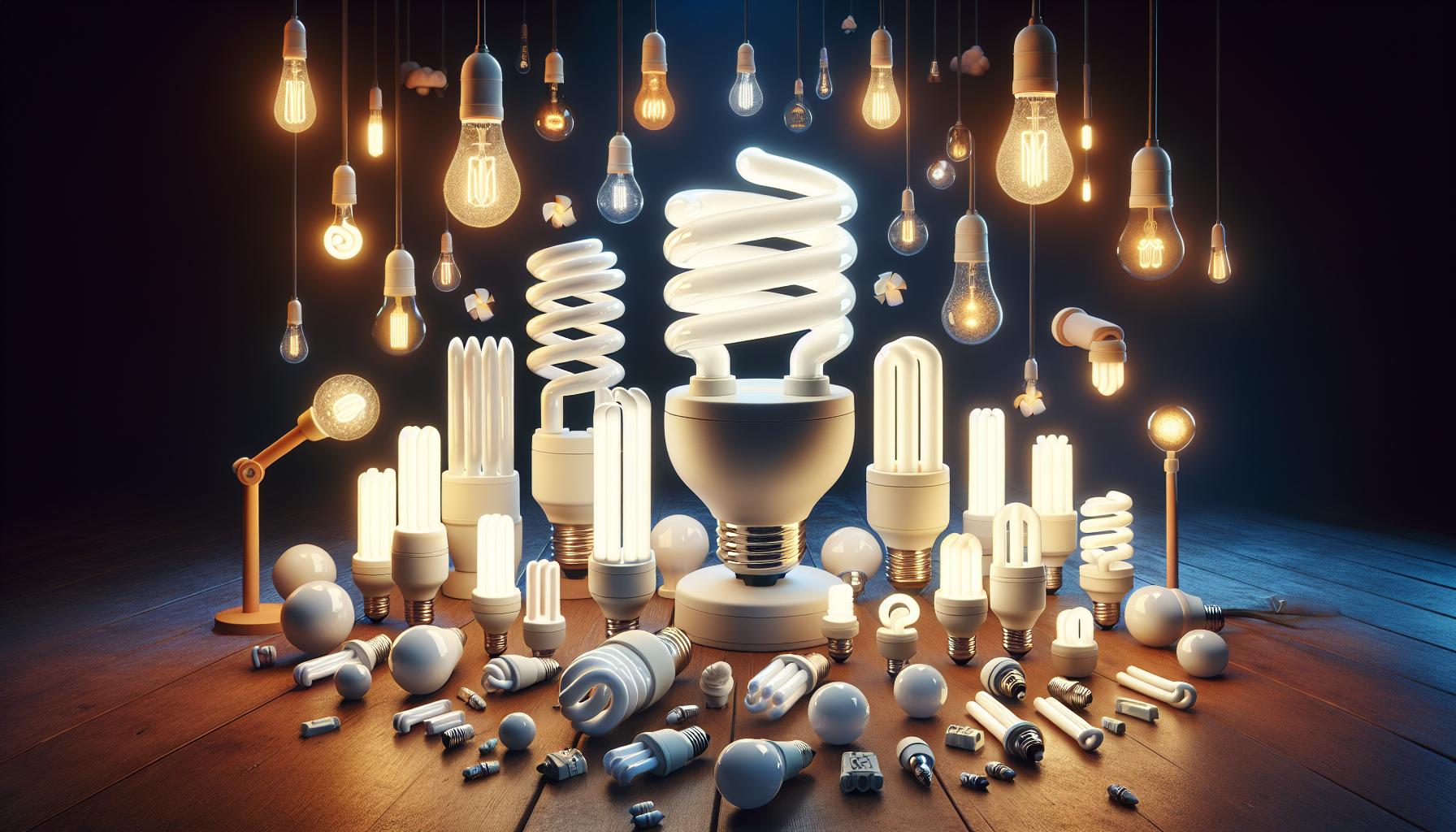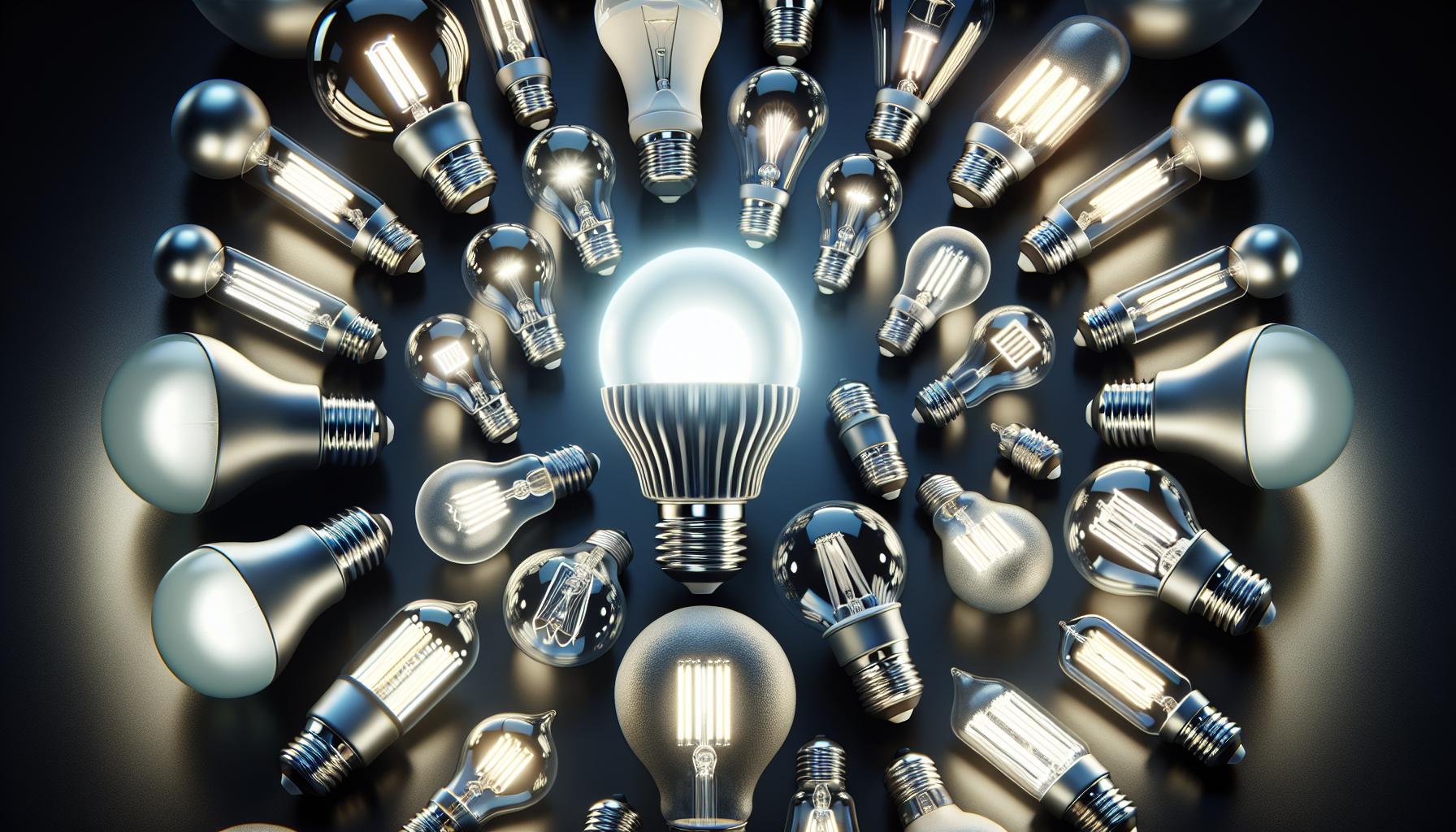Ever flicked on a light and felt the room heat up? You’re not alone. Traditional bulbs are notorious for turning electricity into heat, but there’s good news! Advances in technology mean you’ve got cooler options to brighten your space.

You’re probably wondering which bulbs keep their cool best. Well, you’re in luck! In the quest for a chill vibe and energy efficiency, certain bulbs outshine the rest. Let’s shed some light on the coolest contenders, shall we?
Incandescent Bulbs and Heat Production
When you’re considering lighting options, understanding how incandescent bulbs work is crucial. These have been the go-to choice for generations but they’re notorious for their heat output. It’s all about the way they generate light. Incandescent bulbs pass electricity through a thin filament, typically made of tungsten, which then heats up and glows. This process, unfortunately, results in a lot of energy being lost as heat. In fact, up to 90% of the energy they consume is emitted as heat, not light.
Let’s break it down a little further:
- A standard 60-watt incandescent bulb can run pretty hot.
- Just 10% of the energy used goes toward light production.
- The remaining energy is what makes these bulbs warm to the touch – and they can actually increase the temperature in a room.
Here’s an interesting detail for all you DIY enthusiasts – while the warmth of incandescent bulbs can be a drawback in the summer, it might sometimes help in winter by adding a smidge of extra heat. However, if you’re aiming to keep things cool, this is clearly not ideal.
Are Incandescent Bulbs Cost-Effective?
Since they’re less energy-efficient, you might think they’d pinch your wallet less at the outset. And you’d be right. They’re cheaper upfront compared to more advanced options, but the increased energy use and shortened lifespan can lead to higher costs over time. They tend to last around 1,000 to 2,000 hours, which is significantly lower than their cooler counterparts.
Regarding cost and energy use, let’s compare:
| Type | Lifespan (hours) | Approx. Energy Loss as Heat |
|---|---|---|
| Incandescent Bulb | 1,000 – 2,000 | 90% |
| LED Bulb | 25,000 – 50,000 | 10-20% |
Remember, when you go for an incandescent bulb, you’re mostly paying for heat production, with just a sliver of that cost lighting up your space. Thinking about the energy bill, the ambiance of your room, and the long-term effect on your budget can all influence your decision on whether to stick with this classic or branch out into newer, cooler technologies.
Halogen Bulbs: A Step Towards Efficiency
Halogen bulbs are a classic choice for many homeowners tackling DIY projects. They’re seen as the middle ground in the transition from incandescent to more efficient lighting options. You’ve probably encountered these bulbs in numerous settings, and there’s a good reason for that—they offer a pleasing light quality with better efficiency compared to their incandescent cousins.
Halogen bulbs produce light through a filament enclosed in a compact transparent envelope filled with a halogen gas. This design enhances the bulb’s efficiency and life compared to traditional incandescent bulbs. Although they do generate heat, halogens are about 20% to 30% more energy efficient. Notably, their heat output is still significant, but when it comes to reducing it, you’re headed in the right direction with halogen lamps.
When you’re renovating or just looking to replace a bulb, consider the area you’re illuminating. Halogens are excellent for task lighting, delivering bright, focused light. They’re especially good in places where you need strong, clear light, such as under-cabinet lighting in the kitchen or desk lamps for your home office.
Shopping for halogen bulbs, you’ll find they’re available in a variety of shapes and sizes, allowing for versatility in lighting design and application. Despite the advances, remember they’re not as efficient as LED bulbs and do not boast the same longevity. Yet, this doesn’t overshadow the fact that you will see an improvement in energy consumption and a decrease in heat production if you’re moving away from incandescent bulbs.
As part of your home’s energy-saving strategy, think of halogen bulbs as a step towards a more energy-conscious home—especially if LEDs aren’t suitable for every fixture or your budget just yet. It’s all about taking the right steps towards a brighter, more efficient home lighting system.
Compact Fluorescent Lights (CFLs): Keeping it Cool
« What Light Bulbs Emit the Least Amount of Heat? Discover Energy-Saving Options
What to Do If Light Bulb Exploded: Quick Cleanup and Safety Guide »
When you’re looking for a cooler lighting option, CFLs should be on your radar. Compact Fluorescent Lights, or CFLs, are a solid choice for those aiming to reduce heat output from their light bulbs. Unlike their incandescent relatives, CFLs convert a greater portion of energy into light, which means less of it is wasted as heat.
CFLs work through a different mechanism. They contain a gas that produces ultraviolet light when electrified; this light then excites a fluorescent coating inside the bulb to emit visible light. Efficient energy conversion is the name of the game here, and it translates into less heat. That’s something you might appreciate on those long summer days when you’re trying to keep the AC costs down.
Here’s something else you’ll love if you’re a DIY enthusiast. CFLs come in various shapes, sizes, and even color temperatures, allowing you to customize your lighting to fit your space’s aesthetic. You’re not just choosing a bulb; you’re tailoring your environment. Plus, CFLs can fit in most light fixtures meant for incandescent bulbs, so there’s no need for any extensive rewiring projects.
Moreover, CFLs outshine incandescent bulbs with their longevity. Typically, a CFL can last up to 10 times longer than an incandescent bulb—meaning fewer trips up the ladder to switch them out. While not as long-lived as LEDs, they’re still a savvy choice for energy-conscious consumers.
And let’s talk numbers – in terms of wattage, a 14-15 watt CFL emits about the same amount of light as a 60-watt incandescent bulb. Here’s a quick comparison:
| Bulb Type | Wattage | Equivalent Incandescent Light Output |
|---|---|---|
| CFL | 14-15 W | 60 W |
| Incandescent | 60 W | 60 W |
Don’t overlook the savings on your electricity bill either. With CFLs, your energy use for lighting can drop dramatically. Imagine investing those savings into your next home project or splurging on that stylish lamp you’ve had your eye on.
Light Emitting Diodes (LEDs): The Coolest Choice
As someone passionate about DIY home projects, you’ll find that LED bulbs are your best bet for maintaining a cooler environment. Unlike the incandescent bulbs that convert a significant portion of energy into heat, LEDs are designed to be much more efficient at converting electricity into light, which also means they emit less heat.
LEDs employ solid-state lighting technology, which allows for efficient energy conversion. Essentially, when you power an LED light, electrons move through a semiconductor, emitting light as a result. This process generates very little heat compared to traditional bulbs. In fact, in LEDs, more than 90% of the energy is turned into light, leaving just a sliver for heat production. Here’s how LED bulbs compare to incandescents and CFLs in terms of heat output and energy usage:
| Bulb Type | Efficiency (%) | Heat Produced |
|---|---|---|
| LED | 80-90 | Very Low |
| Incandescent | 10-17 | High |
| CFL | 40-60 | Moderate |
Plus, an immense variety to choose from means LEDs can fit almost any lighting need you have, whether it’s creating ambiance with dimmable lights or brightening up your workspace without overheating it. Their versatility also extends to their size and shape, capable of fitting snugly in the unique light fixtures you’ve assembled for your home.
Durability is another strong suit of LEDs. They aren’t made with glass and don’t have filaments, making them resistant to breakage. Because they operate at a cooler temperature, they’re less prone to burn out from thermal shocks, which happen when a hot bulb comes into contact with cold water. This also contributes to their longer lifespan, often outliving their counterparts by years.
For the eco-conscious DIYer, the adoption of LED lighting is a forward step in reducing your carbon footprint. Lower energy consumption not only trims your electricity bill but also decreases household energy dependence. With LEDs, you’re not just improving your home’s lighting — you’re also making a sustainable choice for the future.
Conclusion
So there you have it—LED bulbs are your best bet for keeping things cool while lighting up your space. They’re not only energy-efficient but also incredibly versatile and eco-friendly, making them a smart choice for both your wallet and the planet. Remember that while halogen and CFLs offer improvements over traditional incandescent bulbs, LEDs lead the pack in minimizing heat output. It’s clear that upgrading to LED lighting is a bright idea that’ll keep your home comfortable and your energy costs down. Happy lighting!
Frequently Asked Questions
Why do incandescent bulbs emit so much heat?
Incandescent bulbs emit a lot of heat because they operate by heating a tungsten filament until it glows, which is a process that inherently produces light and a significant amount of heat as a byproduct.
Can the heat from incandescent bulbs be beneficial?
Yes, the heat from incandescent bulbs can be beneficial in winter to help warm up a room, but it is generally inefficient for cooling purposes during warmer seasons.
Are incandescent bulbs cost-effective?
While incandescent bulbs are cheaper upfront, their increased energy use and shorter lifespan can lead to higher costs over time compared to more energy-efficient lighting options like LEDs and CFLs.
How do halogen bulbs compare to incandescent bulbs?
Halogen bulbs are more efficient than traditional incandescent bulbs, produce less heat, and are suitable for task lighting. They offer a middle ground between incandescent bulbs and more energy-efficient options.
What makes Compact Fluorescent Lights (CFLs) a cooler lighting option?
CFLs are cooler because they convert electricity into light more effectively, producing less heat than incandescent bulbs. They also have a longer lifespan and can lead to energy savings.
Why are LED bulbs considered the best option for keeping a room cool?
LED bulbs are designed to efficiently convert electricity into light, which means they produce considerably less heat compared to incandescent and CFL bulbs. Their low heat output helps maintain a cooler environment.
What are the environmental advantages of LED bulbs?
LED bulbs are energy-efficient, have a longer lifespan, and reduce electricity consumption, which can lead to fewer carbon emissions. Their durability and versatility also contribute to an eco-friendlier lighting option.



